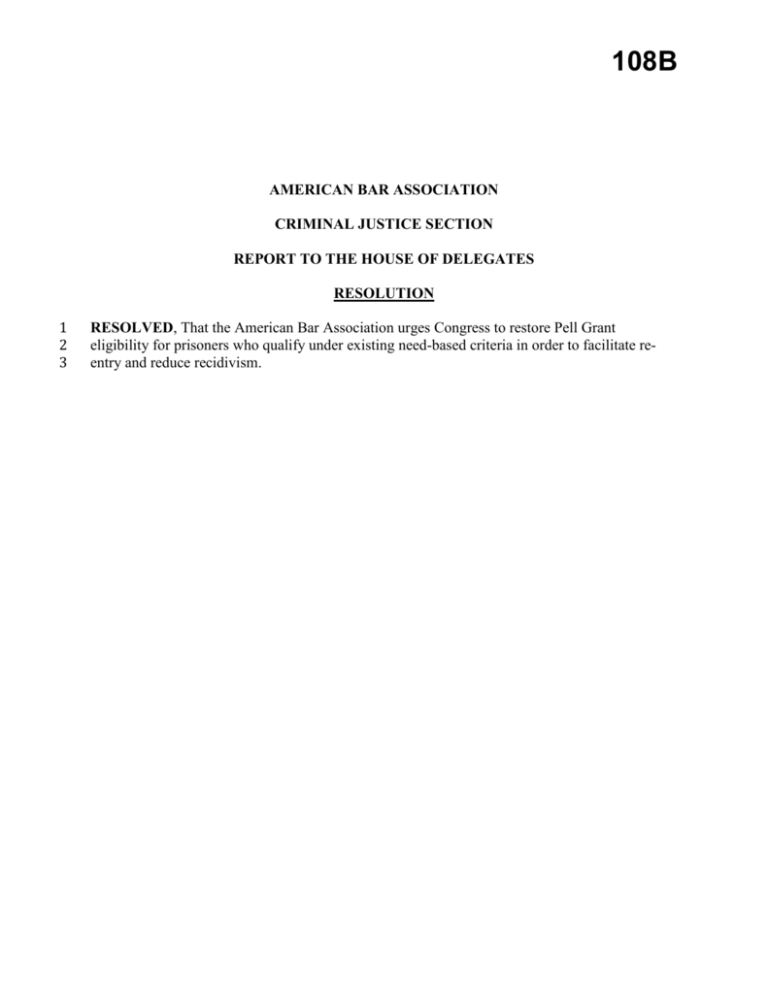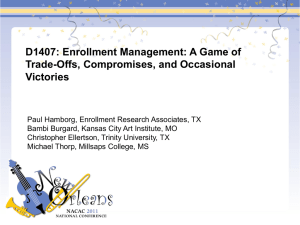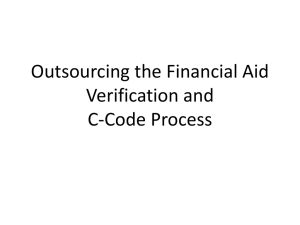108B - American Bar Association
advertisement

108B AMERICAN BAR ASSOCIATION CRIMINAL JUSTICE SECTION REPORT TO THE HOUSE OF DELEGATES RESOLUTION 1 2 3 RESOLVED, That the American Bar Association urges Congress to restore Pell Grant eligibility for prisoners who qualify under existing need-based criteria in order to facilitate reentry and reduce recidivism. 108B Report This Resolution urges Congress to restore Pell Grant funding for prisoners. Pell Grants are not loans and do not have to be repaid. Undergraduate students are eligible for Pell Grants, but incarcerated prisoners are not eligible for the grants. This source of funding was revoked for prisoners two decades ago when Congress passed the Violent Crime Control and Law Enforcement Act in 1994.1 A provision of this Act overturned a section of the Higher Education Act of 1965, which permitted prisoners to receive Pell funding for postsecondary education while incarcerated.2 The provision reads: “No basic grant shall be awarded under this subpart to any individual who is incarcerated in any federal or state penal institution.” The ABA must press Congress to act to reverse this failed law and policy. Two primary rationales support this Resolution. First, in the decades since its enactment, there is little indication that removing prisoners from Pell eligibility has produced any tangible benefits for society; on the contrary, the law may reduce public safety and exact severe social and financial costs. Second, support for reinstatement of Pell funding is consistent with, and expands upon, Association policy3 on education in prison and moves toward actualizing it. There is no illusion that reinstating Pell Grant funding is a cure-all to the question of funding for postsecondary education in prison, but it is a step in the right direction. There is growing momentum for this issue, and most recently a Department of Education note has clarified that some incarcerated individuals are still eligible for Pell Grants.4 The time is ripe for the Association to lend its voice for reform. Restoring the Pell Grant—Increasing Public Safety, Cutting Cost Congress revoked Pell Grant funding for prisoners two decades ago, yet there is little evidence that the law has enhanced public safety, reduced recidivism, or produced taxpayer savings. More certainly, recidivism rates across the country have been dismal, yielding both high financial and social costs. Pell Grant funding directly counters these problems by helping to equip individuals for reintegration into society successfully, with diplomas, skills and certification.5 Pub. L. No. 103-222 (1994). Pub. L. No. 89-329 (1965). 3 American Bar Association, Midyear 1990 Resolution 115C, http://www.americanbar.org/content/dam/aba/directories/policy/1990_my_115c.authcheckdam.pdf . 4 Letter from Lynn B. Mahaffie, Acting Assistant Secretary, United States Department of Education, (Dec. 8, 2014), available at http://ifap.ed.gov/dpcletters/attachments/GEN1421.pdf. 5 See Rachel Mary Gould & SpearIt, Introduction Twenty Years After the Education Apocalypse: The Ongoing Fall Out from the 1994 Ominbus Crime Bill, 33 ST. LOUIS U. PUB. L. REV. 283 (2014); Kenneth L. Parker, The Saint Louis University Prison Program: An Ancient Mission, A New Beginning, 33 ST. LOUIS U. PUB. L. REV. 377, 383-84 (2014) (detailing other research on college-in-prison programs that demonstrated a correlation between college education and reduced recidivism); Kaia Stern, Prison Education and Our Will to Punish, 33 ST. LOUIS U. PUB. L. REV. 443, 452-455 (2014) (discussing the penal and social benefits of higher education in prison). 1 2 1 108B Prisoners first became eligible for federal funding in 1972, when legislation directly allowed for imprisoned individuals to apply for Pell Grants.6 The push to include prisoners for Pell eligibility was consistent with the grant’s design to assist economically challenged Americans working toward postsecondary study and training. For over two decades, prisoners were rightly seen as a part of the economic underclass in America, with the average inmate being impoverished and undereducated. Even prior to entering prison, the men and women living in the correctional system face disadvantage and under-resourcing. According to a 2003 study, approximately 41 percent of prison and jail inmates had not completed high school.7 A decade prior, it was claimed that academic failure and criminal delinquency are welded to “reading failure.”8 More recent data by the Begin to Read Project suggests that 60 percent of all inmates in U.S. prisons and jails are functionally illiterate.9 With such deficiencies among prisoners, the ban on Pell funding was a bombshell for postsecondary education in prison. Although the grant helped to create a robust and growing infrastructure of college and vocational programs in prison, the 1994 legislation single-handedly decimated it. Figures show that in 1990, there were several hundred college programs in prison; following the 1994 legislation, nearly every program disappeared.10 Today, the situation is in survival mode with few prisons offering in-person instruction for degrees and certificates.11 Unlike the legislation’s leveling of higher education in prison, the penological outcomes are less certain. There has been little improvement in public safety, with one study showing that from 1994 to 2007, recidivism rates have remained stagnant.12 This situation is unfortunate given the high rates of recidivism nationwide. According to another study that focused on thirty states, over 75% of released prisoners were rearrested within five years of their release.13 With new offenses and new social harms being committed at such high rates, society continues to bear the brunt of recidivism. Thus, despite other uncertainties about the legislation’s impacts, in the area of reducing social harm, it has scarcely made a difference. The financial returns of the legislation are equally uncertain. To be sure, the quest to revoke Pell funding was partially based on the pretext of saving taxpayer money, yet determining H.R. 92-318, 92nd Cong. (1972) (enacted). Caroline Wolf Harlow, Education and Correctional Populations, BUREAU OF JUST. STAT. 1 (2003), available at http://www.bjs.gov/content/pub/pdf/ecp.pdf. In comparison, only 18 percent of the non-incarcerated public had not completed high school. Id. 8 Michael S. Brunner, Retarding America, the Imprisonment of Potential (1993). 9 Literacy Statistics, Begin to Read, www.begintoread.com/research/literacystatistics.html (last visited May 22, 2014). 10 Rachel Mary Gould & SpearIt, Introduction Twenty Years After the Education Apocalypse: The Ongoing Fall Out from the 1994 Omnibus Crime Bill, 33 ST. LOUIS U. PUB. L. REV. 283, 288 (2014). 11 Id. at 284 note 5. 12 The Pew Center on the States, State of Recidivism: The Revolving Door of America’s Prisons, http://www.pewtrusts.org/~/media/legacy/uploadedfiles/pcs_assets/2011/PewStateofRecidivismpdf.pdf. 13 Durose, Matthew R., Alexia D. Cooper, and Howard N. Snyder, Recidivism of Prisoners Released in 30 States in 2005: Patterns from 2005 to 2010, BUREAU OF JUSTICE STATISTICS SPECIAL REPORT (2014). 6 7 2 108B “costs” and “savings” is complicated. Understanding lost educational opportunity and its effects on recidivism rates is complex, or as one prison instructor describes, “No one will ever know the extent of the loss in unrealized educational goals and dashed dreams of freedom, good jobs, and a crime-free future.”14 Undoubted, however, is that processing, housing, and releasing recidivist offenders strains state and federal coffers, accounting for the main costs of corrections spending that is currently over $52 billion annually.15 Prison institutions stand to benefit in other important ways. For example, inmates in college programs have their time occupied with course attendance and homework, which combats inmate idleness. As such, education as programming curtails behavior that jeopardizes the safety of staff and other inmates. There is less time to participate in the facility subculture of deviance because inmates are busy with class, homework, and mentoring possibilities presented by tutoring, all of which contributes to a safer and humane environment for both staff and inmates. Reaffirming Association Policy This Resolution reaffirms commitment to previous Association policy, which supports the distribution of “grant funds that may be available for correctional education within the Department of Education.” Such funds are needed now more than ever to assist the 700,000 individuals who exit prison each year, only the tiniest fraction of whom experience higher education.16 Prior to the 1994 legislation, prisoners received less than one-half of one percent of the entire Pell budget.17 This number is tiny due to the general under-education of prisoners, who typically do not have a high school diploma or GED, and thus cannot take advantage of Pell funding in the first place. Reaffirming this policy simultaneously disavows the misguided political efforts that led to the ban on Pell funding for prisoners. Paramount among these were the dogmatic adherence to “nothing works” penal philosophy,18 distortions about the cost of Pell funding, and shortsightedness about the penal tradeoffs. Revocation of Pell funding was more political than pragmatic and should not enjoy Association support. As scholars have documented, the claim that “nothing works” became a slogan within a pessimistic narrative of prisoner rehabilitation.19 The study used to substantiate the slogan in John Garmon, The Power of Prison Education, COMMUNITY C. WK., Aug. 5, 2002, at 4. The Pew Center on the States, State of Recidivism: The Revolving Door of America’s Prisons, http://www.pewtrusts.org/~/media/legacy/uploadedfiles/pcs_assets/2011/PewStateofRecidivismpdf.pdf. 16 Heather C. West & William J. Sabol, Prisoners in 2007 3, BUREAU OF JUSTICE STATISTICS, NCJ 224280, available at http://www.bjs.gov/content/pub/pdf/p07.pdf (2008). 17 Daniel Karpowitz & Max Kenner, Education as Crime Prevention: The Case for Reinstating Pell Grant Eligibility for the Incarcerated 7 (2003), available at https://www.stcloudstate.edu/continuingstudies/distance/documents/EducationasCrimePreventionTheCas eForReinstatingthePellGrantforOffendersKarpowitzandKenner.pdf. 18 Cyndi Banks, Punishment in America: A Reference Handbook 95-96 (2005). 19 See Charles B.A. Ubah & Robert L. Robinson, Jr., A Grounded Look at the Debate Over Prison-Based Education: Optimistic Theory Versus Pessimistic Worldview, 83 THE PRISON J. 115 (2003). 14 15 3 108B fact pointed to penal strategies that enjoyed some success. Although the study recognized potential for inmate rehabilitation, “nothing works” became a penal mantra, one that that implicitly made educating inmates pointless.20 Finally, after several attempts to push similar bills through Congress, the 1994 legislation became a legal symbol of this view. At that time there was limited knowledge about the relationship between education and rehabilitation, but that has been changing. Since, there has been greater indication that education in prison is a preventative to reincarceration. According to one study in 1997 that focused on 3,200 prisoners in Maryland, Minnesota, and Ohio, simply attending school behind bars reduces the likelihood of reincarceration by 29 percent.21 In 2000, the Texas Department of Education conducted a longitudinal study of 883 men and women who earned college degrees while incarcerated, finding recidivism rates between 27.2 percent (completion of an AA degree) and 7.8 percent (completion of a BA degree), compared to a system-wide recidivism rate between 40 and 43 percent.22 One report, sponsored by the Correctional Education Association, focused on recidivism in three states and concluded that education prevented crime.23 Although these studies were regional, they suggest that education is an antidote to recidivism. Furthermore, they suggest that an expanded system of higher education nationwide has the potential to impact stagnant recidivism rates positively by lowering them. College and vocational training assists prisoners in what is arguably the greatest challenge to successful reintegration to society—finding gainful employment. It enhances their marketability for the task of staying out of prison. Such views were propounded well before the 1994 legislation, including data presented by Professor James Gilligan in his 1991 Erickson Lectures at Harvard University, declaring that “of all the programs available to prisoners in Massachusetts, the one that was most effective in preventing violence (i.e. recidivism, or (re)offending after they had left prison) was the obtaining of a college degree.”24 Most recently, meta-analysis of programs that provide education to inmates indicates significantly reduced recidivism and greater likelihood of finding employment after release.25 Immediately after the law took effect, the U.S. Department of Education pronounced that the reduction of postsecondary education opportunities would be detrimental to efforts to prevent reincarceration. The Department issued a publication that made a clear argument for the benefit of higher education in prison and its potential to combat recidivism, stating “Pell Grants help Id. at 121. Stephen J. Steurer, et al., Education Reduces Crime: Three-State Recidivism Study, CORR. EDUC. ASSOC., 49 (2001). 22 State of Tex. Leg. Budget Bd. Staff, Statewide Criminal Justice Recidivism and Revocation rates 15 fig.3 (2001), available at http://www.lbb.state.tx.us/Public_Safety_Criminal_Justice/RecRev_Rates/Statewide%20Criminal%20Justice %20Recidivism%20and%20Revocation%20Rates2012.pdf. 23 Banks, supra note 19, at 49. 24 See James Gilligan, Violence in California Prisons: A Proposal for Research into Patterns and Cures (2000), available at http://www.ebookdb.org/reading/3FG3G44B705C332138G71269/Violence-In-CaliforniaPrisons-A-Proposal-For-Research-Into- Patterns-And-Cures. 25 Lois M. Davis et al., Evaluating the Effectiveness of Correctional Education (2013), available at http://www.rand.org/pubs/research_reports/RR266.html. 20 21 4 108B inmates obtain the skills and education needed to acquire and keep a job following their eventual release.”26 Like misguided slogans, false claims about Pell funding must be repudiated. One senator claimed that giving Pell Grants to prisoners shortchanged 100,000 students with no criminal record who were denied because of lack of funds.27 However, according to a study by the General Accounting Office, Pell Grants awarded to prisoners did not affect availability of grants to nonincarcerated students: “If incarcerated students received no Pell grants, no student currently denied a Pell award would have received one and no award amount would have been increased.”28 Everyone with qualifying need received some grant amount, which made the senator’s claim absolutely false. The same Senator stated that prisoners received $200 million in Pell Grant funding, which was later debunked.29 Whether the legislation produces savings is uncertain when factoring in tradeoff costs of forsaken college and vocational training. Research has shown that Pell funding results in a net savings of taxpayer funds and that education may be a better deal than previously imagined, particularly in an environment where basic literacy is a challenge.30 One government study claimed that every dollar spent on education returned more than two dollars to the citizens in reduced prison costs.31 Pell funding fills a critical need for more education in prison in general. Already noted is the low level of education among prisoners, but there has been further reduction in educational resources overall. According to one influential study that compared the number of correctional and educational staff in American prisons, from 1979 to 1995, the prison population tripled while educational staff stayed the same size, resulting in a 60% cut in educational staff per inmate.32 Restoring Pell funding will give more individuals the chance to gain needed social and vocational skills. Educational opportunity does not just help prevent return to prison, but helps in molding citizens who are fully willing and able to participate in our communities. Higher education, whether it is administered within a prison or on a traditional college campus, involves self-discovery, the development of critical thinking skills, and the acquisition of the social and intellectual competencies necessary to navigate the world beyond the campus or prison. Religious studies specifically may be a strong impetus to character change, which involves issues Karpowitz & Kenner, supra note 18, at 6–7. Ian Buruma, Uncaptive Minds, N.Y. TIMES, Feb. 20, 2005, available at http://www.nytimes.com/2005/02/20/magazine/20PRISON.html?_r=0. 28 Letter from Linda G. Morra, Director of Education and Employment Issues, General Accounting Office, to The Honorable Harris Wofford, United States Senate (Aug. 5, 1994) available at http://archive.gao.gov/t2pbat2/152342.pdf. 29 See J.M. Taylor, Pell Grants for Prisoners Part Deux; It’s Déjà Vu All Over Again, 8 J. PRISONERS ON PRISONS 1 (1997), available at http://www.jpp.org/documents/forms/JPP8/Taylor.pdf. 30 See Ibrahim, supra note 16 (advocating for reinstating Pell funding for prisoners and reporting “overwhelming consensus among public officials that postsecondary education is the most successful and cost-effective method of preventing crime”). 31 Ubah & Robinson, supra note 20, at 3. 32 Bruce Western, Punishment and Inequality in America 175 (2006). 26 27 5 108B of morality, discipline, and reflecting theologically on one’s own incarceration.33 Other considerations support this Resolution, including the strong advocacy for restoring Pell eligibility for prisoners.34 The recent Department of Education announcement provided greater clarification for determining “Pell Grant eligibility for students confined or incarcerated in locations that are not federal or state penal institutions.”35 The clarification works to maximize the number of individuals who, while under custody, are still eligible for funding. Restoring prisoner eligibility also advances racial justice. As African Americans and Latinos are disproportionately represented in prison, the elimination of Pell funding equates to greater loss for these specific groups.36 The point was not lost on the NAACP when it urged Congress in 2007, through a formal resolution, to restore prisoner Pell Grant eligibility.37 Finally, restoring Pell eligibility restores the vision of Senator Pell himself who championed the cause of educational opportunity for all—not just those who can pay for it. Pell’s daughter, Dallas Pell, has also urged Congress to honor her father’s legacy by restoring Pell funding to prisoners, which, she writes, “strengthens underserved communities as formerly incarcerated people are most often released into communities that lack the capacity to provide them with employment or reentry assistance.”38 SpearIt, Religion as Rehabilitation? Reflection on Islam in the Correctional Settings, 34 WHITTIER L. REV. 763, 783 (2012). 34 See Leon Neyfakh, Throw the Book at Them, Slate (Jan. 28, 2015), available at http://www.slate.com/articles/news_and_politics/crime/2015/01/should_prisons_offer_degree_granting_co urses_to_convicted_felons_cardinal.html; SpearIt, Restore Pell Grants for Prisoners, Huffington Post (Jan. 16, 2015), available at http://www.huffingtonpost.com/spearit/restore-pell-grants-for-p_b_6488342.html; Ry Rivard, Prison U., Inside Higher Ed (Feb. 28, 2014), available at https://www.insidehighered.com/news/2014/02/28/new-yorks-governor-wants-pay-prisoners-collegeeducation; David Skorton & Glenn Altschuler, College Behind Bars: How Educating Prisoners Pays Off, Forbes (Mar. 25, 2013), available at http://www.forbes.com/sites/collegeprose/2013/03/25/college-behind-barshow-educating-prisoners-pays-off/; Nick Anderson, Advocates Push to Renew Pell Grants for Prisoners, Citing Benefits of Higher Education, Washington Post (Dec. 3, 2013), http://www.washingtonpost.com/local/education/when-congress-cut-pell-grants-forprisoners/2013/12/03/fedcabb2-5b94-11e3-a49b-90a0e156254b_story.html; Jean Trounstine, The Battle to Bring Back Pell Grants for Prisoners, Boston Daily (Mar. 4, 2013), available at http://www.bostonmagazine.com/news/blog/2013/03/04/the-battle-to-bring-back-pell-grants-forprisoners/. 35 Letter from Lynn B. Mahaffie, Acting Assistant Secretary, United States Department of Education (Dec. 8, 2014), available at http://www2.ed.gov/policy/gen/guid/correctional-education/pell-letter.pdf. 36 See Robert Bruce Slater, Locket in but Locked Out: Death Sentence for the Higher Education of Black Prison Inmates?, 6 THE JOURNAL OF BLACKS IN HIGHER EDUCATION 102 (1994-95) (Citing ten states in which Blacks make up two thirds or more of all inmates and stated that cuts in Education grants “will have a hugely disproportionate impact on Blacks”). 37 NAACP, 2009 Resolutions, http://naacp.3cdn.net/e1d563e1232bbae4a0_hbm6id5u7.pdf. 38 Dallas Pell, To Restore Pell Grants in Prisons is to Restore My Father’s Vision of Education Opportunities for All, The Pell Institute, Reflections on Pell 87 (2013), available at http://www.pellinstitute.org/downloads/publications-Reflections_on_Pell_June_2013.pdf. 33 6 108B The ABA urges Congress to reinstate the Pell Grant to prisoners without qualification. By doing so, Congress will honor the legacy of the grant’s namesake and embrace expanded educational opportunities as convergent with both penal and public interests. Respectfully submitted, Jim Felman and Cynthia Orr, Chairs Criminal Justice Section August 2015 7 108B GENERAL INFORMATION FORM Submitting Entity: Criminal Justice Section Submitted By: James Felman and Cynthia Orr., Chairs 1. Summary of Resolution(s). The resolution urges Congress to restore Pell Grant eligibility for prisoners who qualify under existing need-based criteria. 2. Approval by Submitting Entity. This resolution was approved by the Criminal Justice Section Council at its Spring meeting on April 25, 2015. 3. Has this or a similar resolution been submitted to the House or Board previously? No similar resolution has been previously submitted. 4. What existing Association policies are relevant to this Resolution and how would they be affected by its adoption? This resolution is consistent with, and expands upon, resolution115C passed at the 1990 Midyear meeting. 5. If this is a late report, what urgency exists which requires action at this meeting of the House? Not applicable. 6. Status of Legislation. (If applicable) Not applicable. 7. Brief explanation regarding plans for implementation of the policy, if adopted by the House of Delegates. The policy will be distributed to various criminal justice stakeholders as a tool urging grant prisoners access to Pell Grants. The policy will also be featured on the Criminal Justice Section website and in Section publications. 8. Cost to the Association. (Both direct and indirect costs) No cost to the Association is anticipated. 9. Disclosure of Interest. (If applicable) None 10. Referrals. At the same time this policy resolution is submitted to the ABA Policy Office for inclusion in the 2014 Annual Agenda Book for the House of Delegates, it is being circulated to the chairs and staff directors of the following ABA entities: Standing Committees Ethics and Professional Responsibility Federal Judiciary Governmental Affairs Legal Aid and Indigent Defendants Public Education 8 108B Special Committees and Commissions Commission on Youth at Risk Sections, Divisions Government and Public Sector Lawyers Division Individual Rights and Responsibilities Judicial Division Litigation State and Local Government Law Young Lawyers Division 11. Contact Name and Address Information. (Prior to the meeting. Please include name, address, telephone number and e-mail address) Kevin Scruggs Director, Criminal Justice Standards Project American Bar Association 1050 Connecticut Ave. NW, Suite 400 Washington, DC 20036 Phone: 202-662-1503 Fax: 202-662-1501 Email: kevin.scruggs@americanbar.org 12. Contact Name and Address Information. (Who will present the report to the House? Please include name, address, telephone number, cell phone number and e-mail address.) Stephen A. Saltzburg, Section Delegate George Washington University Law School 2000 H Street, NW Washington, DC 20052-0026 Phone: (202) 994-7089; (202) 489-7464 Email: ssaltz@law.gwu.edu Neal R. Sonnett, Section Delegate 2 S. Biscayne Boulevard, Suite 2600 Miami, FL 33131-1819 Phone: (305) 358-2000 Email: nrslaw@sonnett.com 9 108B EXECUTIVE SUMMARY 1. Summary of the Resolution The Criminal Justice Section recommends that the ABA urge Congress to restore Pell Grant eligibility for prisoners who qualify under existing need-based criteria. 2. Summary of the Issue that the Resolution Addresses This Resolution urges Congress to restore Pell Grant funding for prisoners. This source of funding was revoked for prisoners two decades ago when Congress passed the Violent Crime Control and Law Enforcement Act in 1994.39 A provision of this Act overturned a section of the Higher Education Act of 1965, which permitted prisoners to receive Pell funding for postsecondary education while incarcerated.40 The provision reads: “No basic grant shall be awarded under this subpart to any individual who is incarcerated in any federal or state penal institution.” Congress must act on this failed law and policy. 3. Please Explain How the Proposed Policy Position will address the issue Two primary rationales support this Resolution. First, in the decades since its enactment, there is little indication that removing prisoners from Pell eligibility has produced any tangible benefits for society; on the contrary, the law may reduce public safety and exact severe social and financial costs. Second, support for reinstatement of Pell funding is consistent with Association policy on education in prison and moves toward actualizing it. There is no illusion that reinstating Pell Grant funding is a cure-all to the question of funding for postsecondary education in prison, but it is a step in the right direction. There is growing momentum for this issue, and most recently a Department of Education note has clarified that some incarcerated individuals are still eligible for Pell Grants.41 The time is ripe for the Association to lend its voice for reform. 4. Summary of Minority Views None are known. Pub. L. No. 103-222 (1994). Pub. L. No. 89-329 (1965). 41 Letter from Lynn B. Mahaffie, Acting Assistant Secretary, United States Department of Education, (Dec. 8, 2014), available at http://ifap.ed.gov/dpcletters/attachments/GEN1421.pdf. 39 40 10






